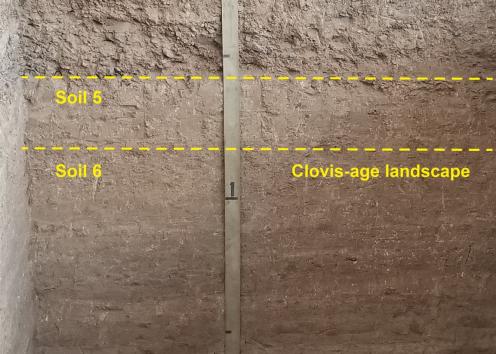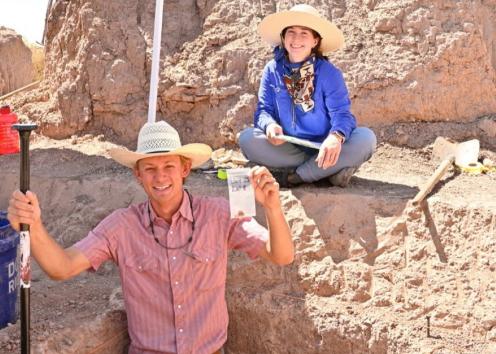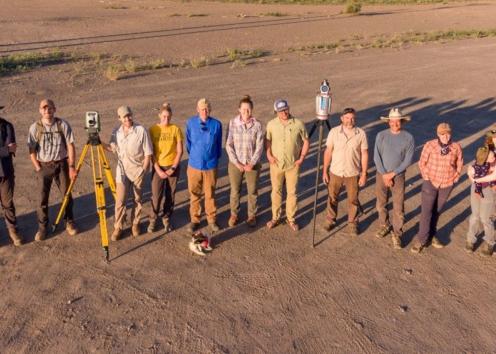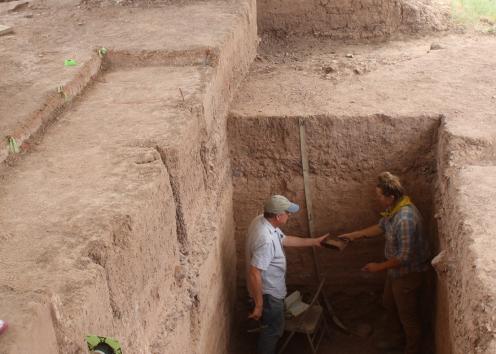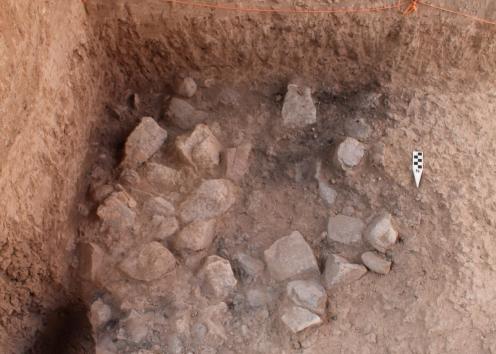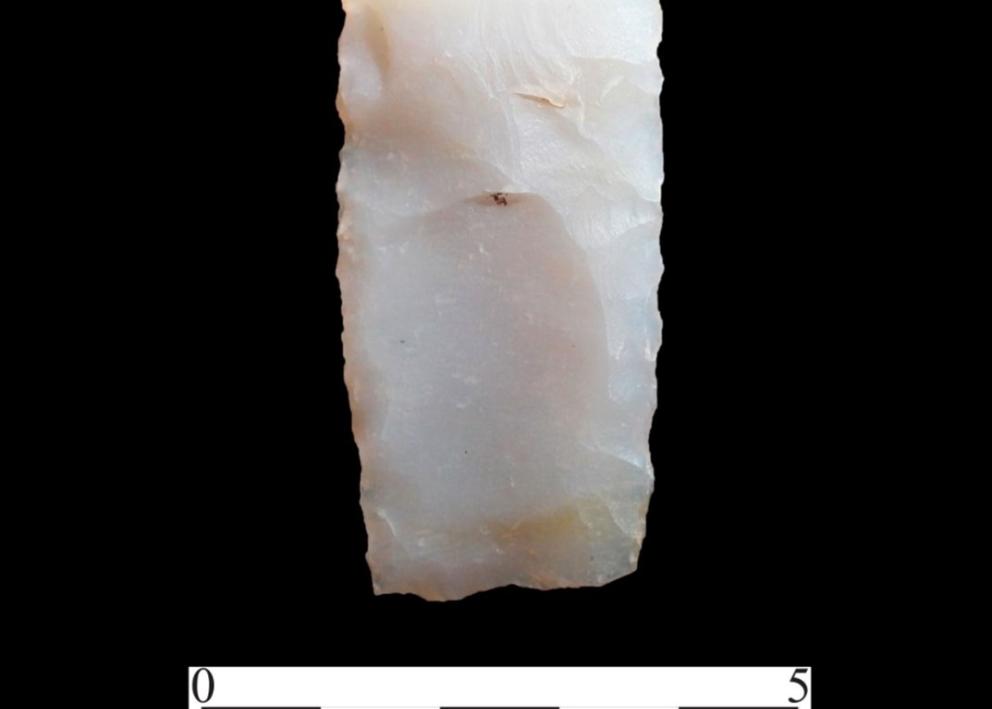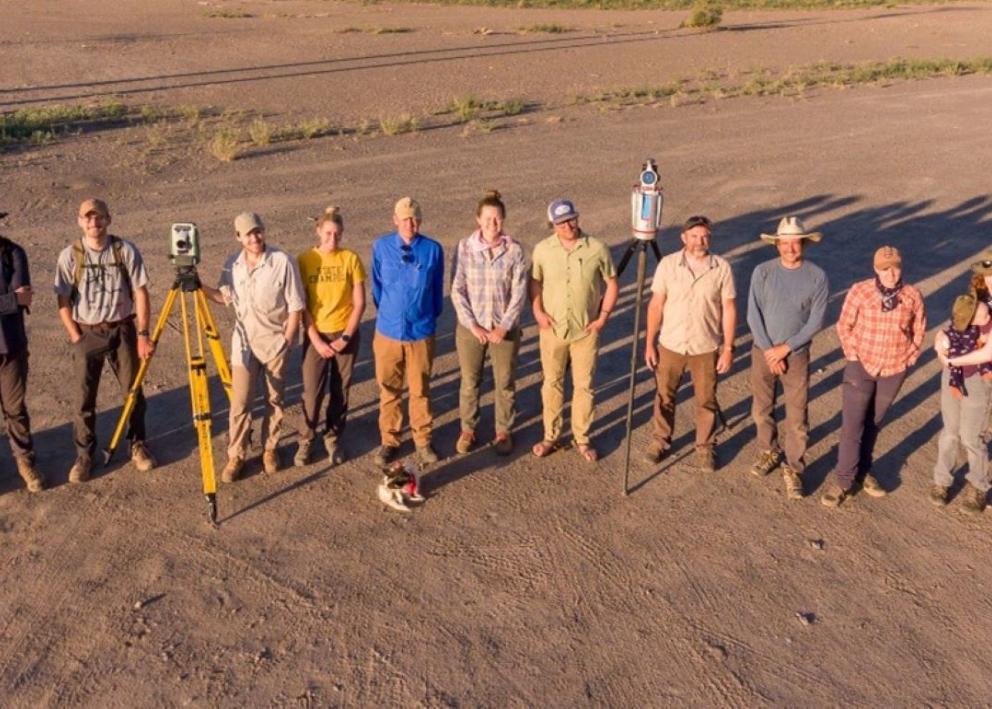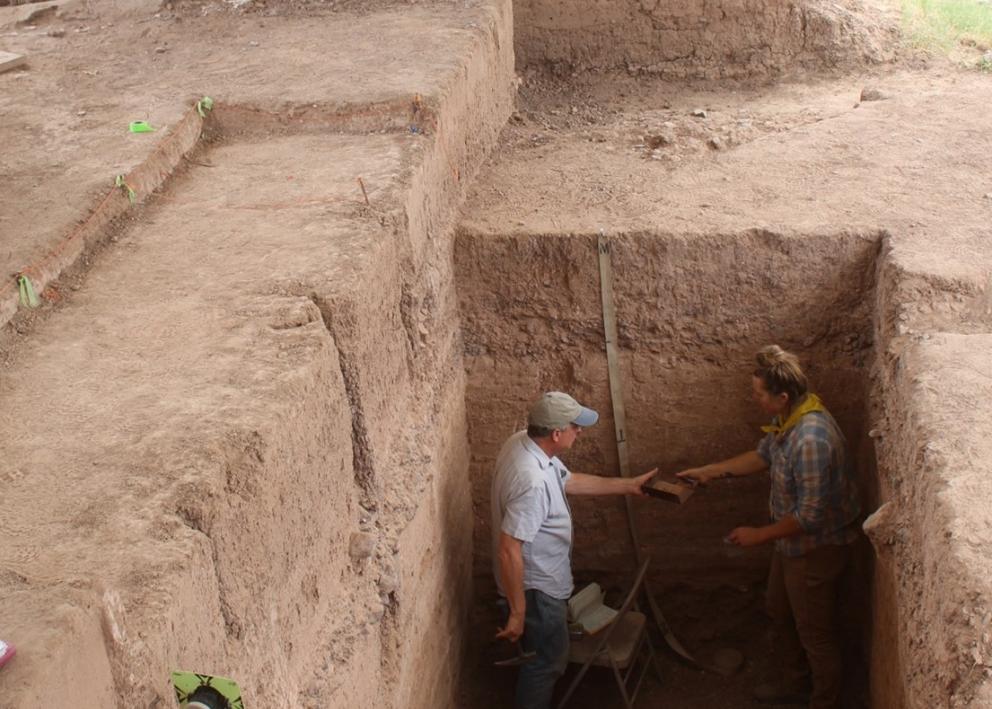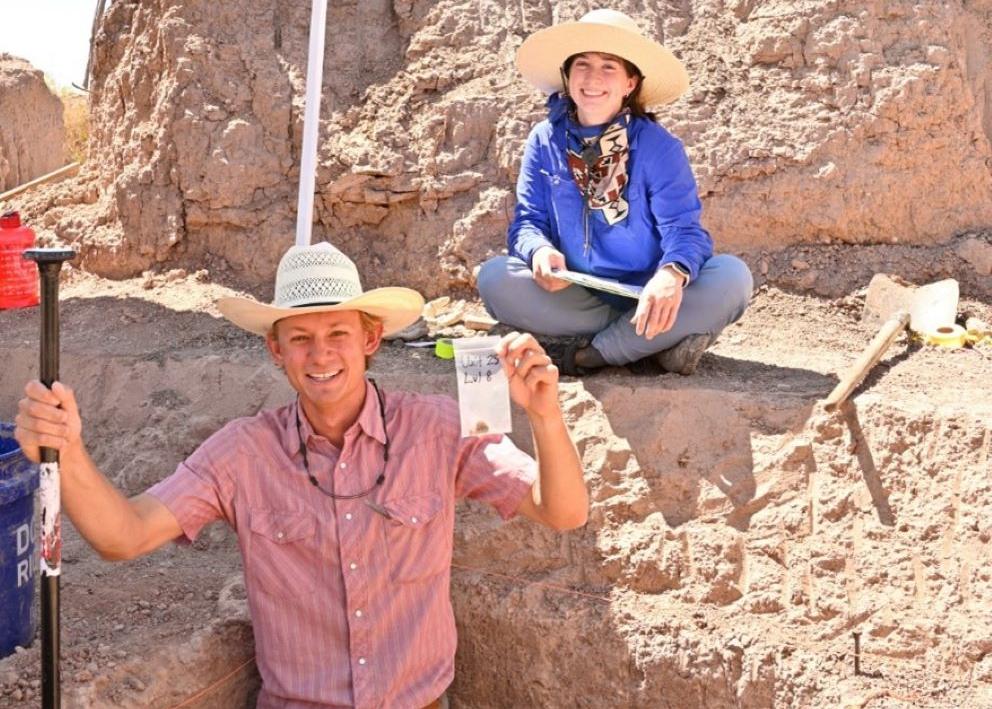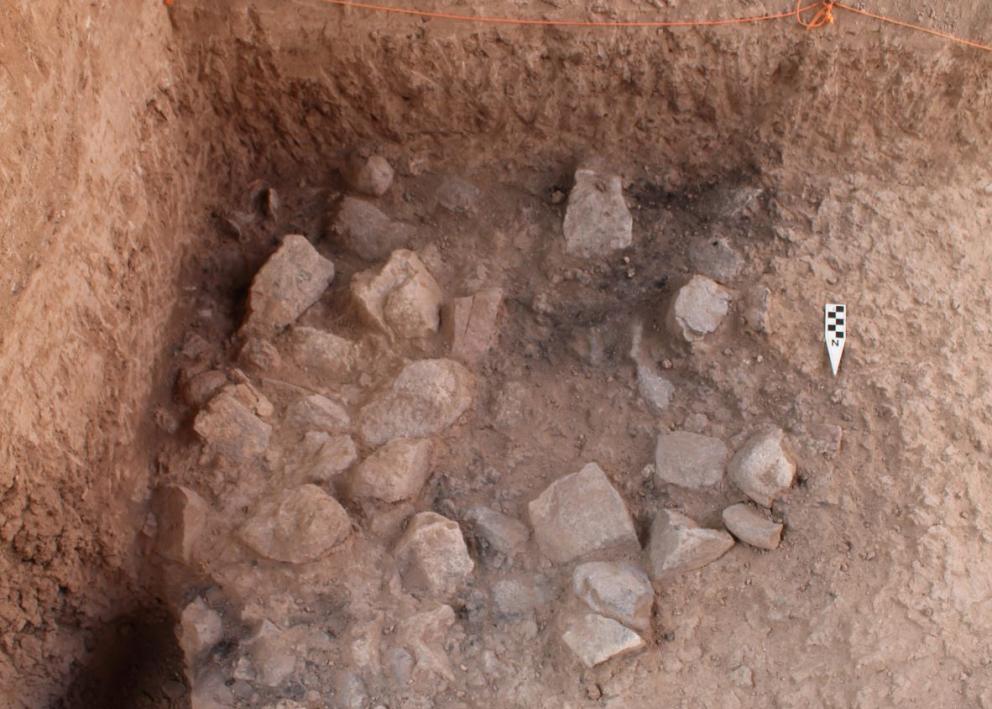Genevieve Lykes Duncan Site

The Genevieve Lykes Duncan site (GLD) is located on the 02 Ranch in western Brewster County, Southwest Texas. The site is situated by an arroyo on an interfluve between Terlingua Creek and Davenport Draw. With watercourses on two sides, the ecotone provided abundant plant and animal resources and an abundance of nearby lithics suitable for the manufacture of stone artifacts. The site is stratified and contains multiple prehistoric occupations, most deeply buried, with a few artifact materials visible on the surface. The first thermal feature on the site was found in a fresh arroyo that cut through the interfluve, providing a window into the buried deposits.
Previous investigations conducted by the Center for Big Bend Studies (CBBS) at the GLD site have firmly established the presence of deeply buried Late Paleoindian and Early Archaic cultural deposits. The cultural deposits are in the form of thermal features that represent various stages of earth oven facilities situated in thick alluvial fills. The earth ovens recovered from GLD are the earliest examples of hot rock oven technology known in North America. The site is especially significant for the Big Bend region of Texas because intact buried Paleoindian sites are rarely encountered. The presence of so few diagnostic Paleoindian materials from this area has led archaeologists to postulate that it may have been unpopulated by Paleoindian groups.
The GLD site is one of few regional locations with considerable promise for Clovis-aged cultural deposits, yet that potential has yet to be thoroughly evaluated. Deep alluvial deposits at GLD also may harbor pre-Clovis cultural deposits. Hence, to assess the potential for Early Paleoindian and pre-Clovis cultural deposits at GLD, the Odyssey research team joined forces with CBBS.
Odyssey Fieldwork at GLD
In 2020, the Odyssey research team and the CBBS carried out excavations at the GLD site over one 12-day session. Specifically, a 2 x 4 m block was hand excavated inside the main excavation block. The 2020 excavation block went 2 m below the known Late Paleoindian occupation, ending in a dense gravel deposit at the bottom of the excavation.
The 2020 excavation at GLD yielded a small amount of cultural material, all associated with the Late Paleoindian component. However, after the excavation was completed, the base of a Clovis projectile point preform was discovered in the backdirt of a former backhoe trench immediately northeast of the main excavation. The preform was found as CBBS finished excavations at three Late Paleoindian thermal features. By the end of the 2020 field season, the Odyssey fieldwork identified a buried soil (Soil 6) below the Late Paleoindian excavations in the main excavation block. This finding initiated a reanalysis of a Clovis-aged radiocarbon date (10,730±150 BP) determined on charcoal collected in 2010 from Soil 6 in Backhoe Trench 4 (BHT 4). Identifying an extensive Clovis-aged soil in the excavations demonstrates the presence of a buried late-Pleistocene landscape (Soil 6) at GLD. Also, the discovery of a definitive Clovis artifact commonly associated with camp activities suggests that a Clovis occupation is associated with this buried landscape.
The focus of the 2021 Odyssey field season at GLD was to establish a new excavation block, map the site with a GeoSLAM LiDAR scanner and a JAVAD Triumph-LS Plus GPS that collects high-resolution spatial data, and collect additional chronometric control from the main excavation block. Most of the fieldwork involved using heavy equipment to open the area adjacent to where the Clovis preform was found. The focus was a 4 x 4 m area between BHT 8 and BHT 14, where the alluvium above the known Late Paleoindian component was removed with a backhoe and hand tools. The excavation was ceased once the 4 x 4 m area was level across the top of the Neville Member of the Lykes Formation. The excavation did not continue because the base of the Neville sediment package contains the Clovis-aged soil, and leaving the overburden protected the deposits for the 2022 Odyssey field session.
In 2022, the 4 x 4 m block excavated in 2021 immediately adjacent to the backhoe trench (BHT10) that previously yielded the Clovis preform was widened to 5 x 5 m. To help verify depths, a backhoe trench was excavated to the southwest of the new 5 x 5 m block. During excavation of the trench, an earth oven was recorded at approximately the same depth as the 10,000-year-old earth ovens previously documented at the site. Most of the feature was still intact and charcoal from it yielded an uncalibrated radiocarbon age of 8,147±38 B.P., which calibrates to a mean probability of 9,082 B.P. Hence, despite its depth, the oven is not as old as anticipated.
After the 5 x 5 block was established, four 1 x 1 m units were excavated in the northwest corner of the grid and two 1 x 1 m units were excavated close to the backhoe trench that yielded the Clovis preform. All units were excavated by hand down to and through Soil 6.
Given the recovery of a Clovis preform at GLD, it was determined that an Early Paleoindian hunting camp probably occurs below the Late Paleoindian components at GLD. Clovis camps tend to be ephemeral because Early Paleoindian groups were small and nomadic and typically did not leave much of a material record on the landscape. The exception is kill sites where the remains of large mammoth or extinct bison occur. Because GLD does not represent a kill site, there was only a remote chance of finding a Clovis camp during the 2022 Odyssey excavation. However, in Unit 25, three flakes were discovered well below the gravel bed that occurs beneath the Late Paleoindian occupation. The flakes were at the same depth as the Clovis-aged charcoal (10,730±150 uncalibrated B.P.) recovered from the adjacent trench that was previously excavated in the channel of the arroyo. Also, a small fragment of charcoal found slightly above the surface of Soil 6 in Unit 21 yielded an uncalibrated radiocarbon age of 11,606±48 B.P. That age is consistent with the numerical age of the Clovis cultural period. Hence, it now seems much more plausible that a deeply buried Clovis camp occurs at the GLD site, and based on our findings, additional excavation units are warranted along the eastern edge of the 5 x 5 m block. In 2023, Odyssey excavations will focus on that edge of the block.
GLD Crew 2020: Dr. Rolfe Mandel (KU Professor and Director of Odyssey), Dr. Bryon Schroeder (Director of the Center for Big Bend Studies at Sul Ross State University), Mason Niquette (KU graduate student), Josh Collins, Chris Hord, Paige Englert, Nic Redford, Kara Johannesen, Eden Meadows, and Erika Blecha.
GLD Crew 2021: Dr. Rolfe Mandel (KU Professor and Director of Odyssey), Dr. Bryon Schroeder (Director of the Center for Big Bend Studies at Sul Ross State University), Mason Niquette (KU graduate student), Beth Potter (KU graduate student), Josh Collins, Chris Hord, Nic Redford, Indiana Sorrel, and Erika Blecha.
GLD Crew 2022: Dr. Rolfe Mandel (KU Professor and Director of Odyssey), Dr. Bryon Schroeder (Director of the Center for Big Bend Studies at Sul Ross State University), Josh Collins, Chris Hord, Natalie Nickels, and Erika Blecha.
Volunteers: Brooke Gerdes, Thomas Morales Denham, Morgan Robledo, Debra Dillard, Dan Dosedel, Dalton Stevens, Sam Stone, Johnny Villarreal, David Wellborn, and Chris Yarbrough.
